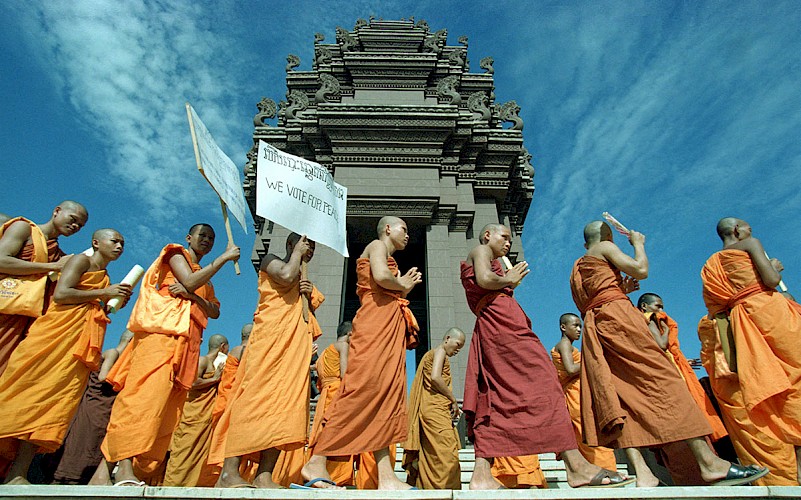
Buddhist monks march and pray for a peaceful election on Sunday, as they arrive at the Independance monument in Phnom Penh July 24, 1998. Cambodians and the international community hope the general election will restore democracy and stabilitiy in the country which was thrown into crisis in July last year when Second Prime Minister Hun Sen toppled his senior coalition partner and co-premier, Prince Norodom Ranariddh.
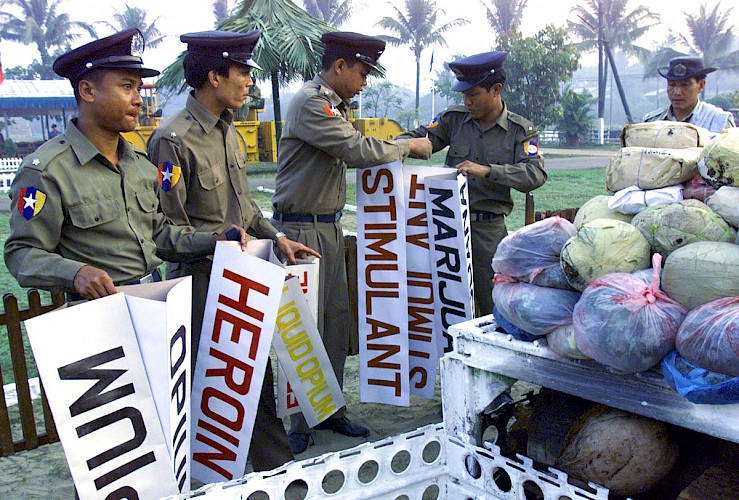
Soldiers prepare a bonfire of drugs at a police compound in Yangon. About four tonnes of raw opium, 430 kilos of heroin, 34 kilos of morphine, 163 kilos of marijuana and 15.4 million amphetamine tablets worth a total of over US$200 million are torched in a police compound during a ceremony attended by delegates attending an Interpol conference on heroin in Yangon. Myanmar, a major world producer of opium, predicted that stepped-up government suppression of poppy growing in remote areas and bad weather would cut output of the drug sharply.
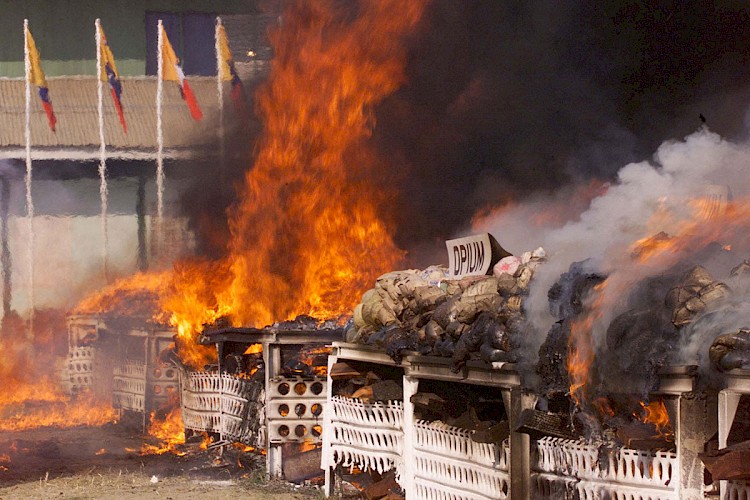
About four tonnes of raw opium, 430 kilos of heroin, 34 kilos of morphine, 163 kilos of marijuana and 15.4 million amphetamine tablets worth a total of over US$200 million are torched in a police compound during a ceremony attended by delegates attending an Interpol conference on heroin in Yangon. Myanmar, a major world producer of opium, predicted that stepped-up government suppression of poppy growing in remote areas and bad weather would cut output of the drug sharply.
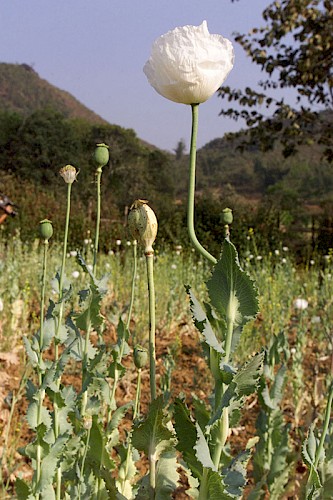
A poppy grows outside Low Soi, a village in the Shan state in northeastern Myanmar close to the border with China February 26. Myanmar authorities took delegates of the 4th International Heroin Conference to one of the few opium growing areas which has escaped the government's anti-drug campaign. Myanmar, a major world producer of opium, predicted that stepped-up government suppression of poppy growing in remote areas would cut output of the drug sharply this year.
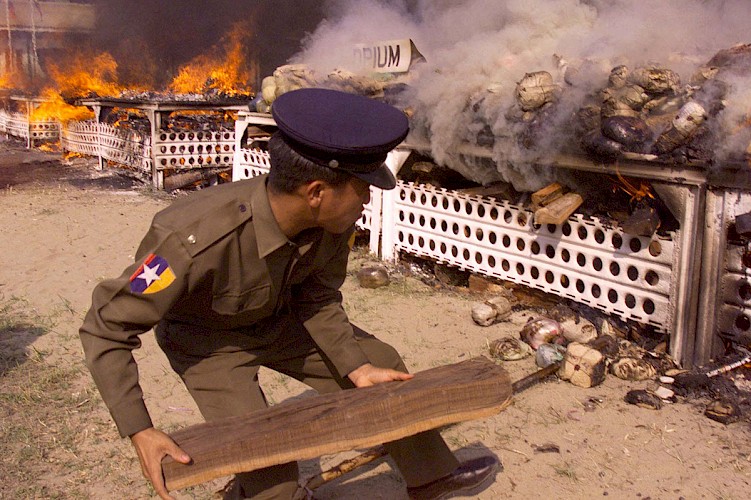
A Myanmar soldier puts a log of wood under bags of opium burnt in a police compound in Yangon. About four tonnes of raw opium, 430 kilos of heroin, 34 kilos of morphine, 163 kilos of marijuana and 15.4 million amphetamine tablets worth a total of over US$200 million are torched in a police compound during a ceremony attended by delegates attending an Interpol conference on heroin in Yangon. Myanmar, a major world producer of opium, predicted that stepped-up government suppression of poppy growing in remote areas would cut output of the drug sharply this year.
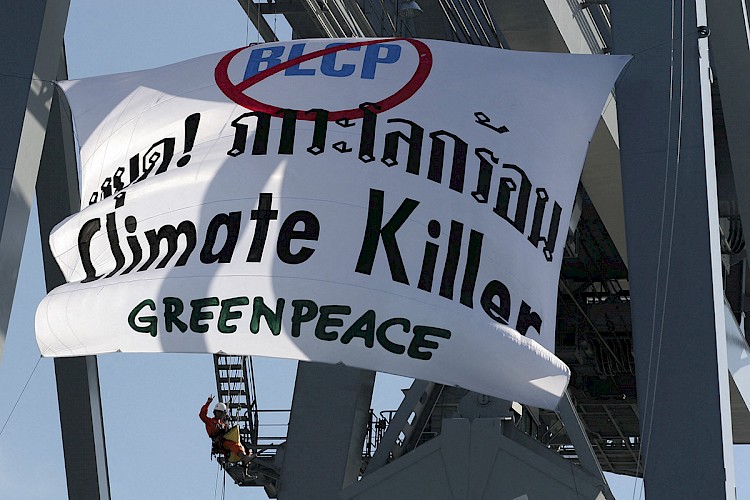
A Greenpeace activist makes a victory sign under a banner set on a crane on the construction site of of a power plant built in Rayong, Thailand, Wednesday, Dec. 7, 2005. The Rainbow Warrior is on a 10-week tour of Asia to sound the alarm about dangerous climate change. BLCP is the develpper of a 1,434 MW coal fired power statgion in Map Ta Phut industrial estate in the Rayong province of Thailand.
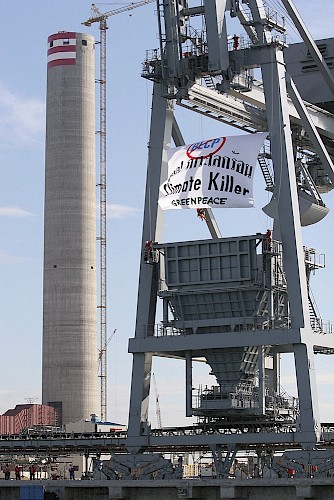
With its flagship the Rainbow Warrior looking on, Greenpeace activists climbed the loading crane of the BLCP coal plant at Map Ta Phut in Thailand and unfurled banners demanding the plant’s immediate closure, calling on the Thai government to phase out coal power and to commit to renewable energy, Wednesday, Dec. 7, 2005. The Rainbow Warrior is on a 10-week tour of Asia to sound the alarm about dangerous climate change. BLCP is the develpper of a 1,434 MW coal fired power station in Map Ta Phut industrial estate in the Rayong province of Thailand.
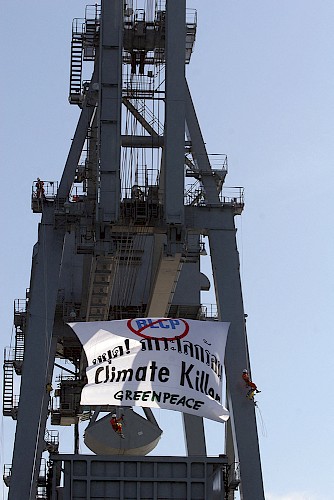
With its flagship the Rainbow Warrior looking on, Greenpeace activists climb the loading crane of the BLCP coal plant at Map Ta Phut in Thailand and unfurled banners demanding the plant’s immediate closure, calling on the Thai government to phase out coal power and to commit to renewable energy, Wednesday, Dec. 7, 2005. The Rainbow Warrior is on a 10-week tour of Asia to sound the alarm about dangerous climate change. BLCP is the develpper of a 1,434 MW coal fired power station in Map Ta Phut industrial estate in the Rayong province of Thailand. Greenpeace/Patrick de Noirmont/OnAsia.
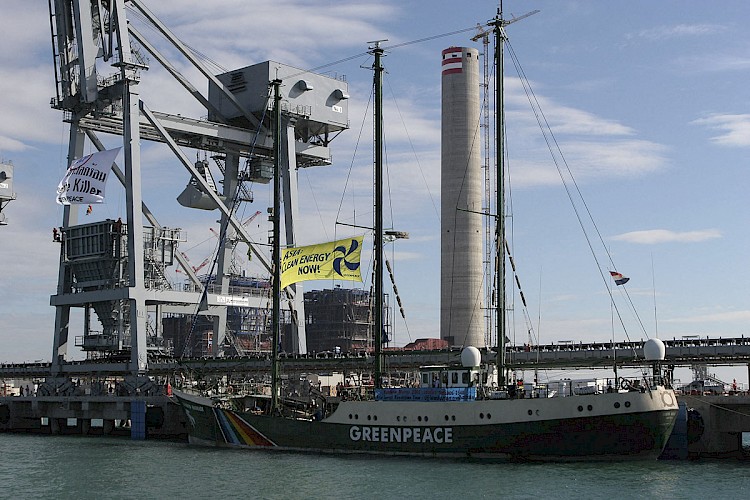
With its flagship the Rainbow Warrior looking on, Greenpeace activists climbed the loading crane of the BLCP coal plant at Map Ta Phut in Thailand and unfurled banners demanding the plant’s immediate closure, calling on the Thai government to phase out coal power and to commit to renewable energy, Wednesday, Dec. 7, 2005. The Rainbow Warrior is on a 10-week tour of Asia to sound the alarm about dangerous climate change. BLCP is the develpper of a 1,434 MW coal fired power station in Map Ta Phut industrial estate in the Rayong province of Thailand. Greenpeace/Patrick de Noirmont/OnAsia.
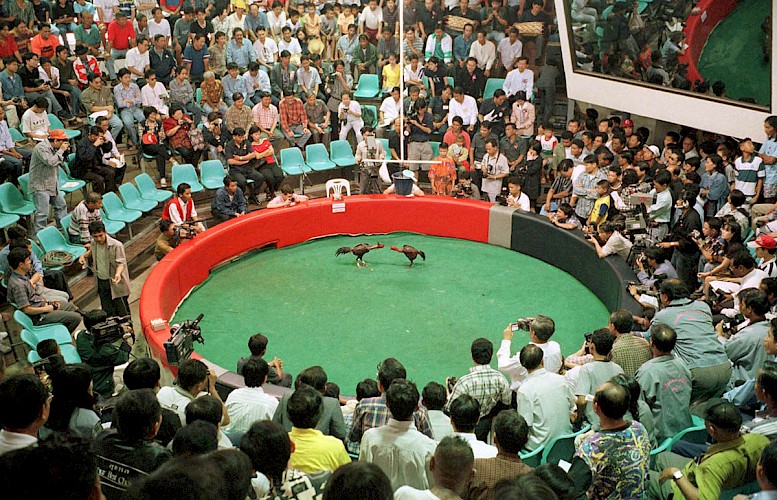
Cockerels are ready to fight for a large audience at the worlds's first International Amateur Cockfighting Competition in Chonburi, 150 km northeast of Bangkok February 7, 1999. Thai fighting cocks are the most popular in Asia and exports generate 100 million baht (US$2.7 million) a year. A top fighter can fetch 100,000 baht (US$2,750) at post-fight auctions. Many of the best go for breeding, or onto the lucrative, but more hazardous professional circuit.
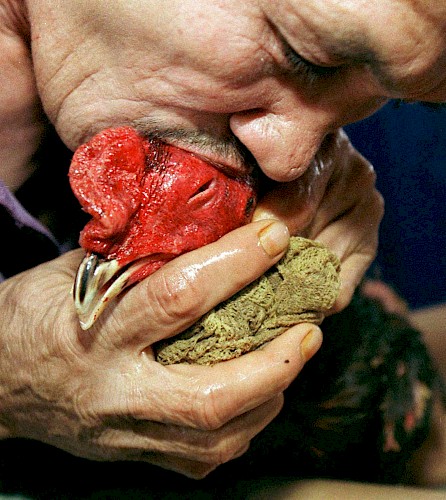
CHONBURI,THAILAND,7FEB99 - A trainer sucks blood from the head of a fighting cock during a break at the worlds's first International Amateur Cockfighting Competition in Chonburi, 150 kilometres northeast of Bangkok February 7. Thai fighting cocks are the most popular in Asia and exports generate 100 million baht (US$2.7 million) per year. A top fighter can fetch 100,000 baht (US$2,750) at post-fight auctions. Many of the best go for breeding, or onto the lucrative, but more hazardous professional circuit.
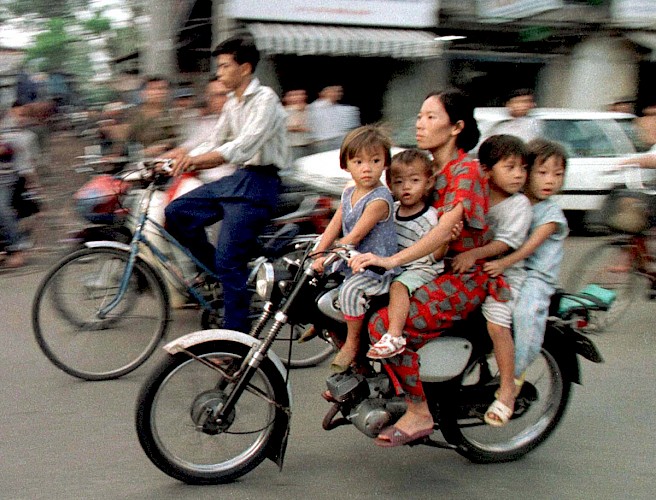
a woman and four children squeeze onto a small motorbike as it heads through the crowded streets of central Ho Chi Minh City. Latest figures show that since the start of the year Vietnam's notoriously dangerous streets account for least 42 serious traffic accidents a day. Picture taken 13NOV97.
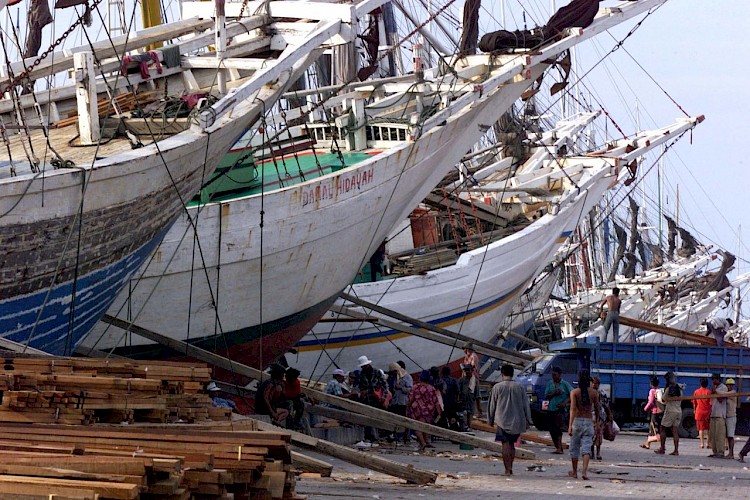
Traditional Indonesian sailing boats called "pinisi" are moored in Sunda Kelapa in the old Jakarta November 28, 1998. The 17-meter-long schooners come from Kalimantan, Sulawesi and Sumatra carrying timber for West Java. Jakarta was first known as Sunda Kelapa, the harbor of the Indu-Javanese Pajajaran kingdom from the 12th century to the 16th century. Ships used to come from neighboring islands as well as from India, South China and later Portugal and Holland to buy pepper, rice and gold.
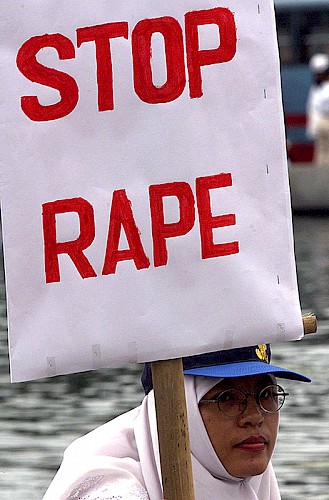
An Indonesian woman holds a placard denouncing rapes in her country during a demonstration in central Jakarta November 25, 1998. Most Indonesians want to dump their deeply unpopular president, B.J. Habibie, according to a rare opinion poll published on Wednesday amid fresh anti-government protests in the capital.
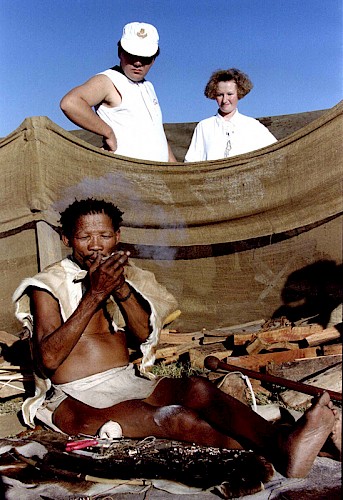
Bushman Petrus Kruiper, 76, dressed in animal skins, smokes as he is exhibited like a zoo animal May 5, 1996 at the annual fair in Klersdorp, about 110 km west of Johannesburg. For only two rand (46 U.S. cents) the South African public can stare at two Bushmen, in their hessian-cloth enclosure, next to a lioness and a hyaena cub in adjoining wire pens.
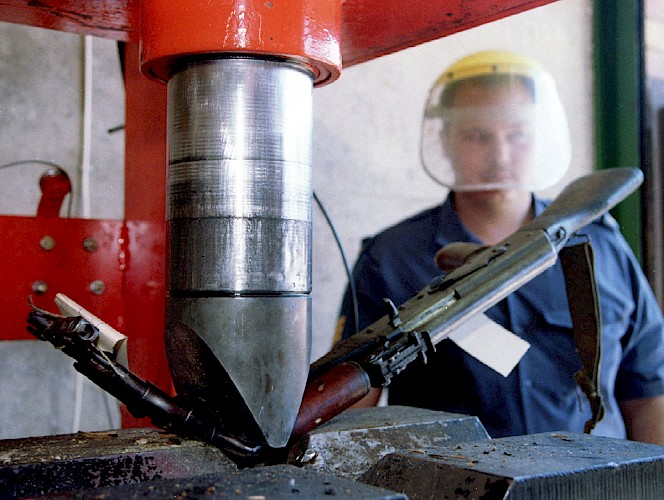
South African police crush AK--47 assault rifles in a 100-tonne metal press before melting them down at the police logistics centre in the South African capital October 19, 1994. The rifles, from a stock of 1,900 to be destroyed, were broken on the fifth day of a week-long amnesty for people handing in illegal arms and ammunition.
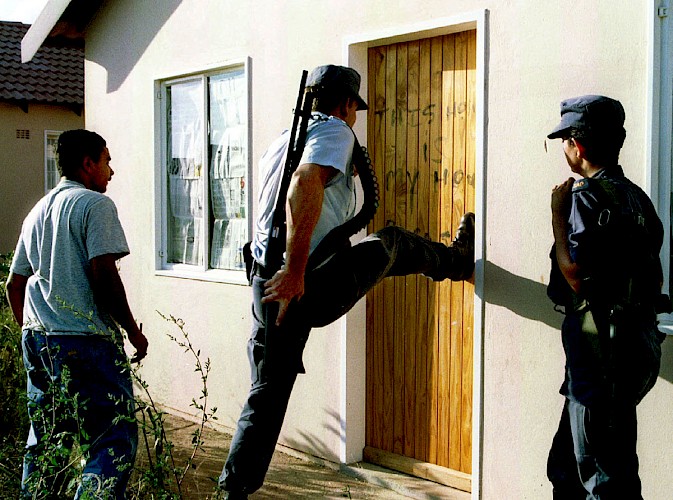
A South African soldier breaks the door of a house after paratroopers landed next to the "Las Vegas" squatter camp, 50 km east of Johannesburg June 18, 1996, as part of a crime fighting operation. Police said they had arrested more than 1,000 people around the commercial capital in the 10 days since launching "Operation Lynx", which they said was an all-out war on crime.
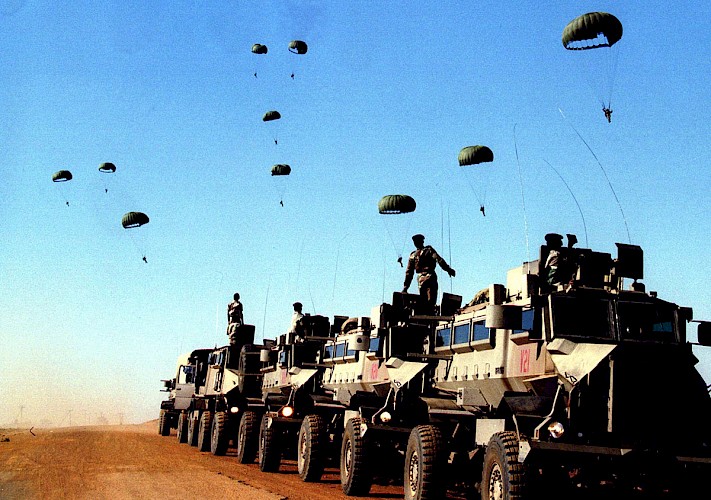
South African soldiers watch as paratroopers land next to the "Las Vegas" squatter camp, 50 km east of Johannesburg June 18, 1996, as part of a crime fighting operation. Police said they had arrested more than 1,000 people around the commercial capital in the 10 days since launching "Operation Lynx", which they said was an all-out war on crime.
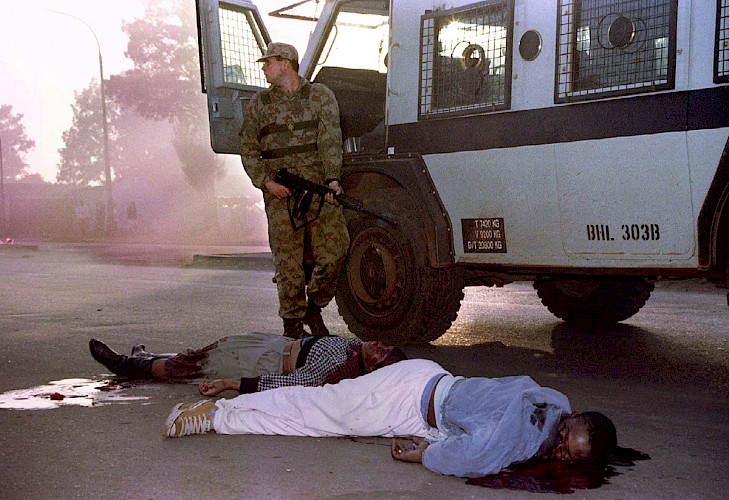
An armed policeman checks the surroundings as his armoured vehicle stops by the bodies of a man and a woman shot dead minutes earlier in front of the entrance of a hostel in this black township east of Johannesburg August 2, 1993.
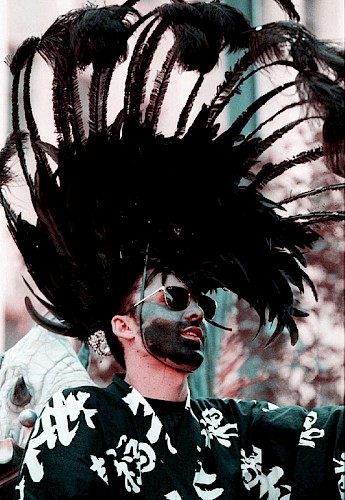
A young man wearing an ostrich feather hat parades in the commercial capital October 1, 1994, with gays and lesbians celebrating the inclusion of their rights in South Africa's interim constitution.
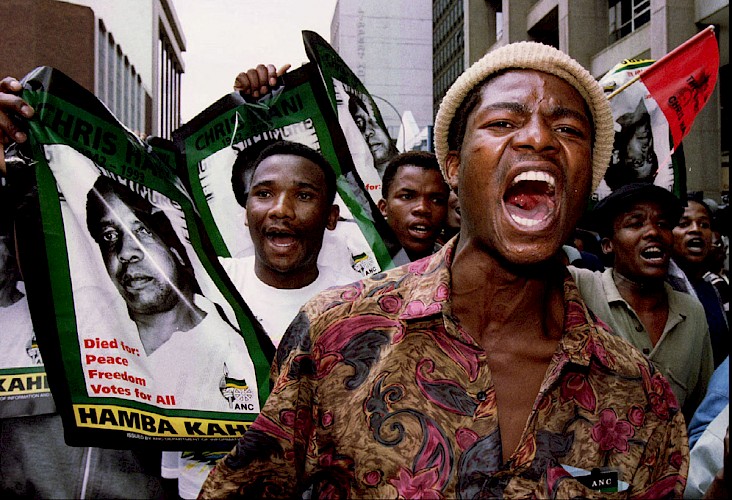
Demonstrators carry posters of slain South African Communist Party leader Chris Hani and shout slogans around the Rand Supreme Court October 4, 1993, at the opening of the trial of Hani's alleged murderers.
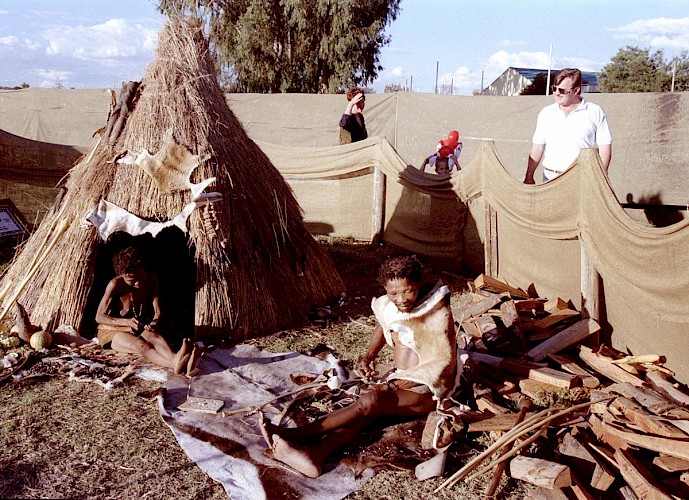
Bushman Petrus Kruiper (R), 76, and his wife Oulap Kruiper (Old Rag Crawler), 50, dressed in animal skins, thread beads to make necklaces as they are exhibited like zoo animals May 5, 1996, at the annual fair in Klerksdorp, about 110 km west of Johannesburg. For only two rand (46 U.S. cents) the South African public can stare at these Bushmen, in their hessian-cloth enclosure. From early days, Bushmen were hunted on Sundays as a sport by Africans and British settlers.
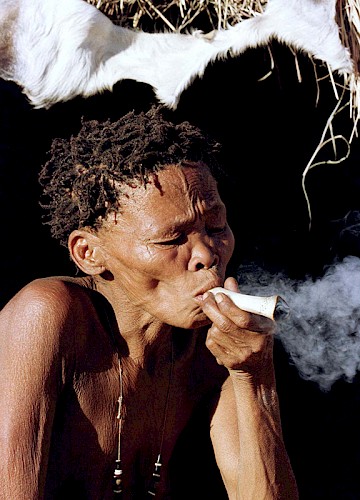
Bushman Oulap Kruiper, 50, sits outside her grass hut and smokes a bone pipe along with her husband, at the annual fair of Klerksdorp, about 110 km west of Johannesburg, May 7, 1996. For thousands of years the small people freely roamed the dunes, plains and mountains of southern Africa, hunting wild animals and gathering plants for food.
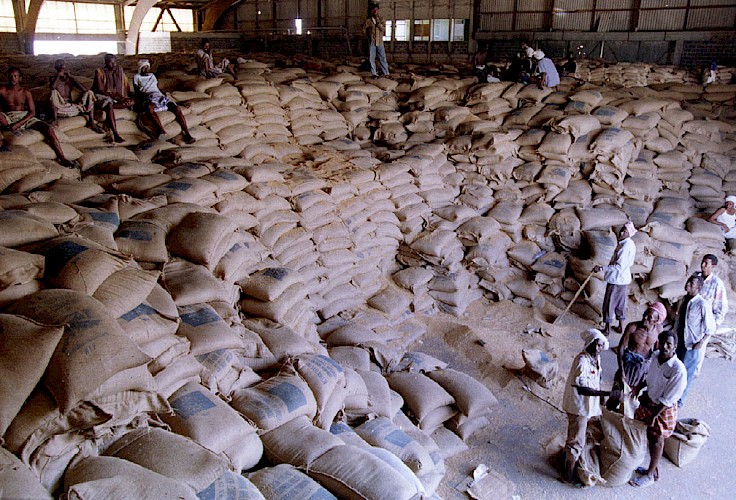
Destitute Somalis get a two-kilo scoop of wheat at a distribution centre February 6, 1993.
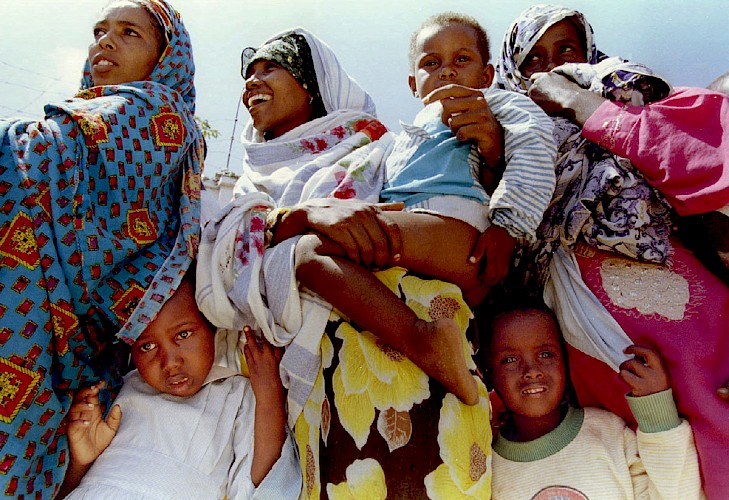
Somali women and their children queue outside a clinic in the suburbs of Mogadishu October 16, 1993.
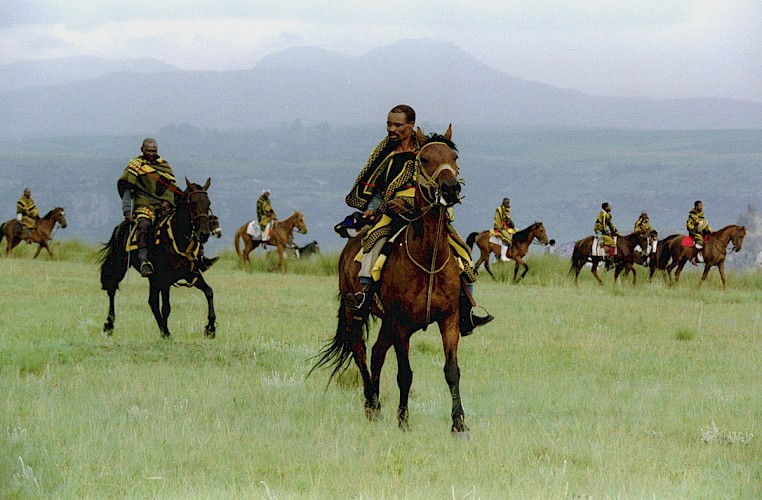
Horsemen in tribal dress gather on the top of the Thaba Bosiu mountain to attend the burial of Lesotho King Moshoeshoe II January 26, 1996. The mountain, 35 km east of the Lesotho capital Maseru, served as a stronghold for the Basotho during 19th century wars against the British and Boers.
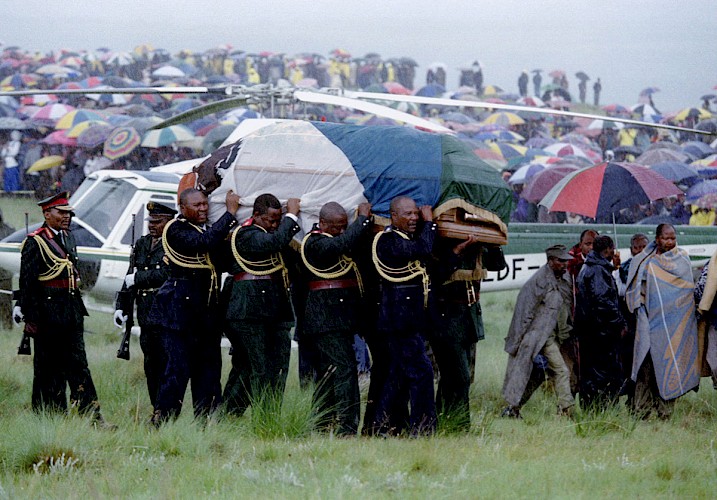
The royal guard carry the coffin of Lesotho King Moshoeshoe II, under heavy rain, from an helicopter to his grave on the top of the Thaba Bosiu mountain January 26, 1996. The mountain, 35 km east of the Lesotho capital Maseru, served as a stronghold for the Basotho during 19th century wars against the British and Boers.
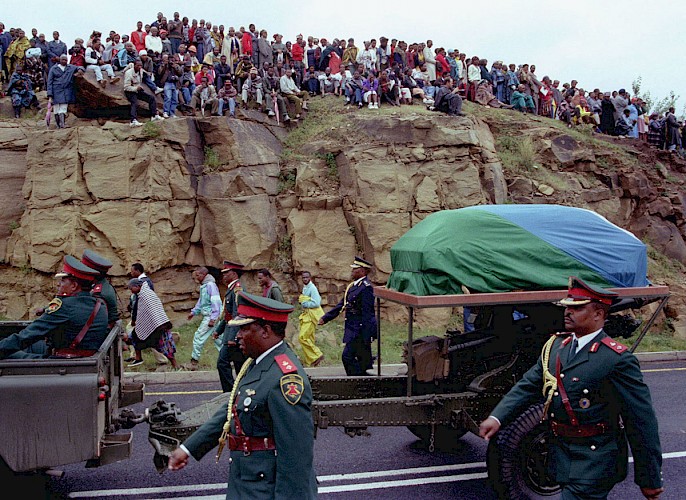
Lesotho King Moshoeshoe II's subjects gather on the foothills of Thaba Bosiu to watch the king's coffin, draped in a royal standard, trundle by on a gun carriage January 26, 1996. Moshoeshoe II, 57, died in a car accident on a mountain road January 15.
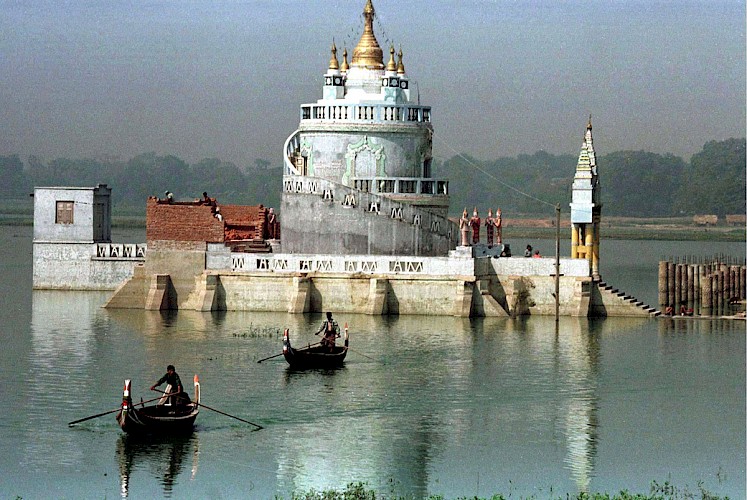
Riverboats ply the waters near a Buddhist temple on the Taungtaman lake, a few kilometers south of Mandalay in central Burma February 27, 1997. There are 8,000 kilometers of navigable rivers in Burma that remain central to the daily life. Nomadic fishing villages move as the rivers change through the seasons.
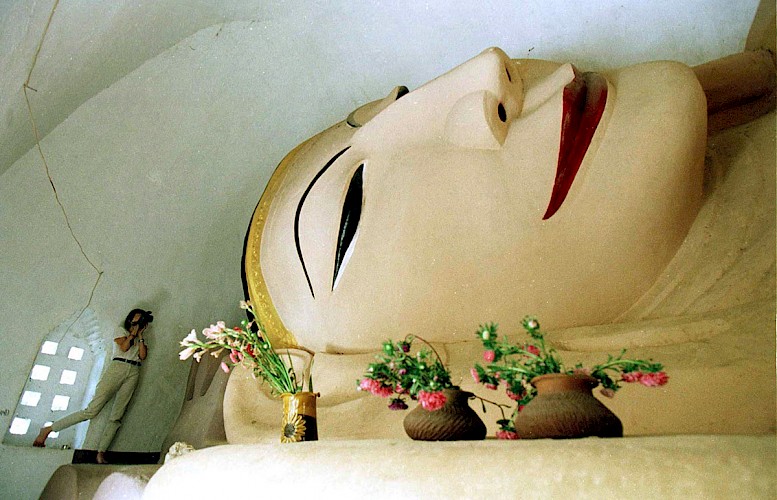
A tourist films Manuha Temple's colossal Reclining Buddha in the area of Pagan in central Burma February 26, 1997 . Pagan was shaken by a powerful earthquake in 1975 and many of the more important temples were badly damaged. Reconstruction started almost immediately and still goes on. Many monuments are being rebuilt using traditional methods.
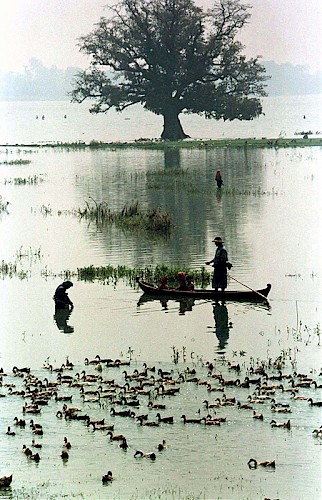
Burmese fishermen navigate around ducks in Taungtaman Lake, a few kilometres south of Mandalay in central Burma February 27. Rivers and lakes in Burma remain central to daily life. Nomadic fishing villages move as the rivers change through the seasons.
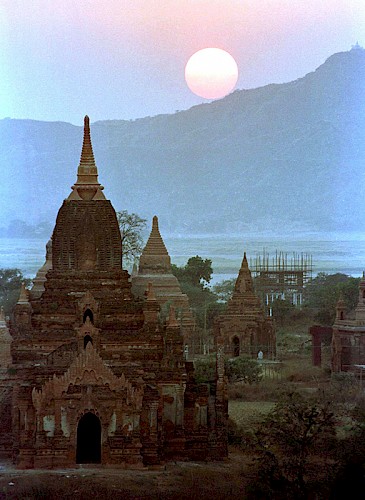
The sun sets on the Ananda Temple in the old Pagan archeological zone in central Burma Feburary 26, 1997. Pagan was shaken by a powerful earthquake in 1975 and many of the more important temples were badly damaged. Reconstruction started almost immediately and still goes on. Many monuments are being rebuilt using traditional methods.































